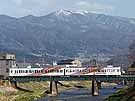
Crossing a bridge over a stream is a series 3000 set introduced from the Keio Inogashira Line last year. "Highland Rail" marked on the side of the train must be the line's catch phrase representing "Kamikochi".
By Hiroshi Naito
There is an 80-year old small private railway in Shinshu Matsumoto
in Nagano prefecture about 230 km northwest of Tokyo. Shinshu is a
regional term given the area of Nagano prefecture. One can associate
Shinshu with
beautiful scenery sorrounded with high mountains with snow on top and
clean air in rustic circumstances. The entire area of Shinshu is
mountainous, and sitting in a basin in the central part of it is
Matsumoto, a medium-sized city. Following Nagano city, the prefectural
capital, Matsumoto flourishes as the next biggest regional center in
Shinshu for business and industries. With the peaks of mountains of the
Japanese Northern Alps just west of the city, Matsumoto is situated at
an entrance to the Northern Alps which are popular for mountaineering
and Kamikochi, one of the most popular mountainous sightseeing spots
located at the foot of the Northern Alps.
The private railway is the Matsumoto Electric Railway's Kamikochi
Line
running from JR Matsumoto station westwards up to New-Shimajima. As
represented by the line's name, it mainly functions as an access route
to
Kamikochi, with a line length of 14.4 km. The trackage is on single
track of 1,067 mm gauge electrified all the way at 1,500 V DC. The line
goes through the flat land of a basin in a rustic landscape surrounded
with mountains including the Northern Alps to the west.
The origin of the Matsumoto Electric Railway is the Chikuma Electric
Railway opened in 1921 connecting Matsumoto and Shimajima and targeting
sightseeing passengers and mountaineers traveling to Kamikochi and
further to climb the Northern Alps. The service route shrunk by 1.3 km
when the western-most section between Shimajima and New-Shimajima was
abandoned in 1983 because of a landslide caused by a typhoon which hit
in 1982. Now, New-Shimajima serves as the terminus where bus
connections to Kamikochi are well provided.
The service is pretty quiet with a frequency of fourty minutes,
although
during the morning peak on weekdays the headway is increased up to 20
minutes. For service, the line operates a sole fleet of the series 3000
introduced from the Keio Electric Railway's Inogashira Line in Tokyo in
August 2000. Between 1986 and 2000, the line's fleet used to use the
ex-Tokyu 5000 series, which was epoch-making stock on private railways
after the World War II in terms of high-performance with various modern
technologies.
Matsumoto can be reached in two hours and thirty to fifty minutes
from
Shinjuku/Tokyo by JR limited express along the Chuo Main Line. There is
nothing particularly special on the Kamikochi Line as to railway
features with its simple service structure, but you may be impressed
with the pure, peaceful scenery along the line with farmland stretching
as far as
the surrounding mountains in the distance.
The following pictures were taken in April 2000 by the author.